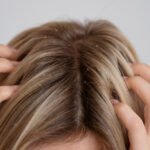Hairfall is a common concern for many, but it’s essential to understand that losing some hair every day is entirely normal. The challenge lies in distinguishing between normal hair shedding and excessive hair loss, which might indicate an underlying problem. Here’s how to determine if your hairfall is within the normal range or if it’s time to seek professional advice.
Understanding the Hair Growth Cycle
Before diving into the specifics of hairfall, it’s crucial to understand the hair growth cycle, which consists of three main phases:
- Anagen (Growth Phase): This phase lasts 2-7 years, during which the hair grows actively.
- Catagen (Transitional Phase): Lasting about 2-3 weeks, this phase is when hair growth slows, and the hair follicle shrinks.
- Telogen (Resting Phase): This phase lasts around 3 months. During this period, the hair rests before eventually falling out to make way for new growth.
On average, losing 50-100 hairs per day is considered normal due to this natural hair growth cycle.
Factors Influencing Hairfall
Several factors can influence the amount of hair you shed daily, including:
- Age: Hair naturally thins with age.
- Hormonal Changes: Pregnancy, menopause, thyroid issues, and hormonal imbalances can affect hair growth.
- Diet: Nutrient deficiencies, especially in protein, iron, and vitamins, can lead to hair loss.
- Stress: Physical or emotional stress can push hair follicles into the telogen phase prematurely.
- Hairstyling: Excessive use of heat, chemicals, and tight hairstyles can damage hair and cause it to fall out.
Signs of Normal Hairfall
- Daily Shedding: Losing 50-100 hairs per day is typical. You might notice hair in your brush, on your pillow, or in the shower drain.
- Even Distribution: Normal hair shedding occurs evenly across the scalp. If you notice hair falling out uniformly without specific patches, it’s likely within the normal range.
- Hair Regrowth: If you can see small, fine hairs growing back in the areas where you shed hair, it indicates a healthy hair growth cycle.
Signs of Abnormal Hairfall
- Excessive Shedding: Losing significantly more than 100 hairs a day can be a sign of abnormal hairfall. If you notice large clumps of hair coming out when you brush or wash your hair, it might be a concern.
- Thinning Hair: Visible thinning, especially at the crown or temples, can indicate excessive hair loss.
- Bald Patches: The appearance of bald spots or patches is a clear sign of abnormal hairfall.
- Change in Texture: If your hair suddenly becomes brittle, dry, or changes in texture along with increased hair loss, it could indicate an underlying issue.
- No Regrowth: If you don’t see new hair growth where you have lost hair, it could suggest a problem.
Common Causes of Excessive Hairfall
- Androgenetic Alopecia: Also known as male or female pattern baldness, this genetic condition leads to gradual hair thinning.
- Alopecia Areata: An autoimmune disorder causing sudden hair loss in patches.
- Telogen Effluvium: A temporary condition often triggered by stress, illness, or drastic weight loss, leading to excessive hair shedding.
- Traction Alopecia: Hair loss due to tight hairstyles pulling on the hair follicles.
- Nutritional Deficiencies: Lack of essential nutrients can weaken hair and cause it to fall out.
When to Seek Professional Help
If you’re concerned about your hairfall, it’s always best to consult a healthcare professional or dermatologist. Seek advice if you experience:
- Sudden or rapid hair loss
- Noticeable thinning or bald patches
- Accompanying symptoms like itching, redness, or scalp irritation
- No visible regrowth of hair after several months
Understanding the difference between normal hair shedding and excessive hair loss is key to maintaining healthy hair. Regular hairfall is a natural part of the hair growth cycle, but if you notice signs of abnormal hair loss, it’s important to address the issue promptly.
Image credits: Image by benzoix on Freepik








No Comment! Be the first one.